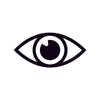HOW DO I KNOW IF I’M HAVING AN OCULAR MIGRAINE? WHAT CAUSES MIGRAINES?
OCULAR migraines are caused by reduced blood flow or spasms of blood vessels in the retina or behind the eye. It is a rare occurrence and is often confused with the more common VISUAL migraine (a.k.a. migraine with aura) or a HEADACHE which can be a symptom of a different issue.
AM I HAVING AN OCULAR MIGRAINE OR A VISUAL MIGRAINE?
One can differentiate between an OCULAR (rare) and VISUAL (more common) migraine by the effects or symptoms they have on vision.
An OCULAR migraine is characterized by temporary vision loss in ONE eye. The small blind spot generally affects central vision and gets larger, making it impossible to do things such as drive safely read.
A VISUAL migraine may cause any of the following visual problems to BOTH eyes:
-
A flickering blind spot ( either central or paracentral)
-
A zigzag pattern of coloured light surrounding a central blind spot such as looking through a cracked window
-
A migrating blind spot that slowly moves across the visual field
The disturbances caused by any migraine will typically resolve after 1 hour.
AM I HAVING AN OCULAR MIGRAINE OR AM I HAVING A DIFFERENT HEADACHE?
The difference is that an ocular migraine is the ILLNESS, whilst a headache is a SYMPTOM for something else. Headaches can be indicators for more serious issues (this may also include headache behind eyes). Hence, it is important to know the difference.
The next time you believe you are having an ocular migraine, ask yourself the following questions to determine the migraine symptoms:


